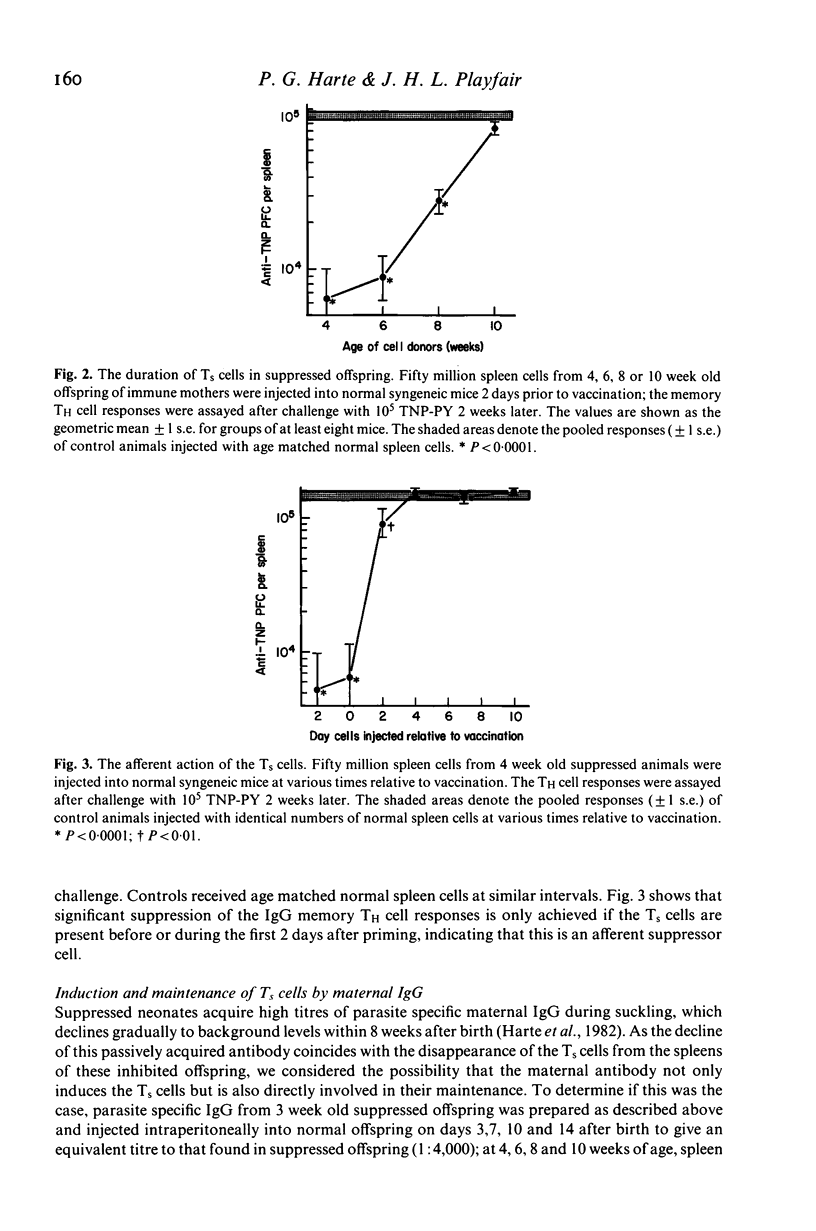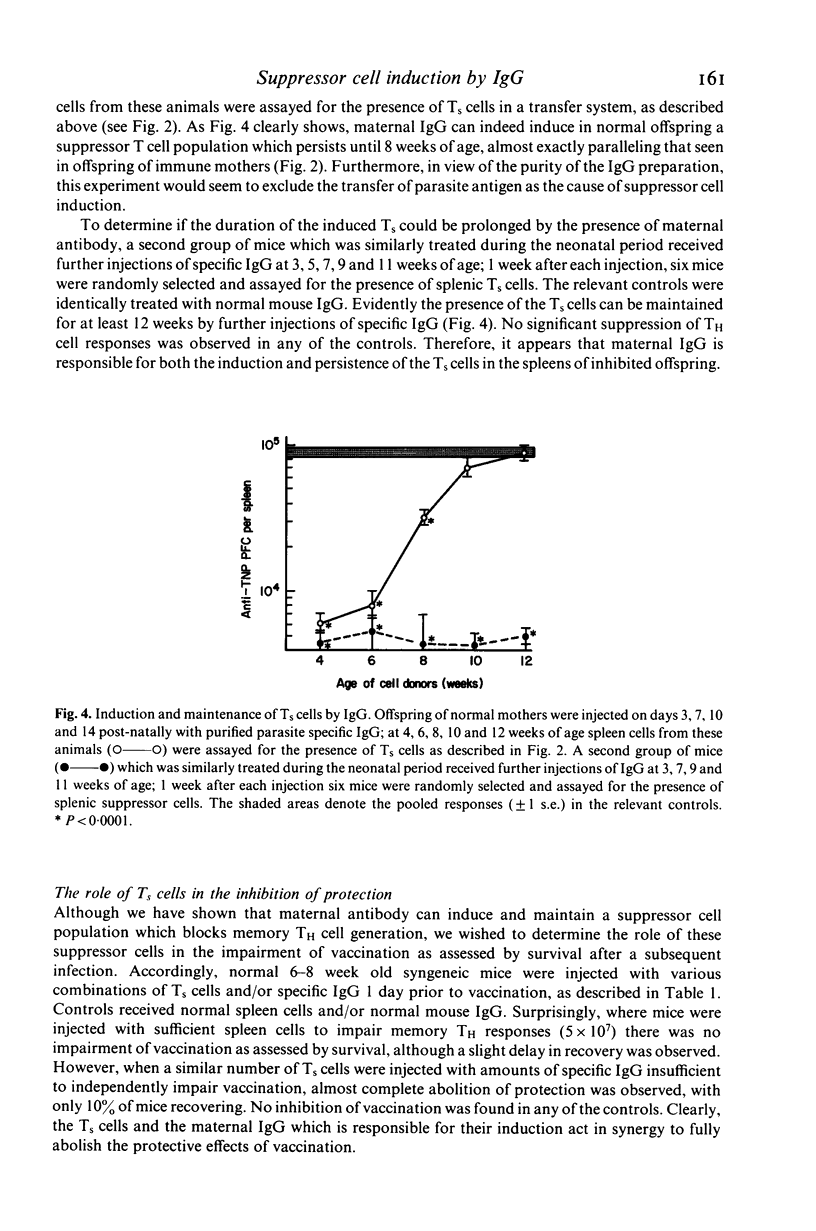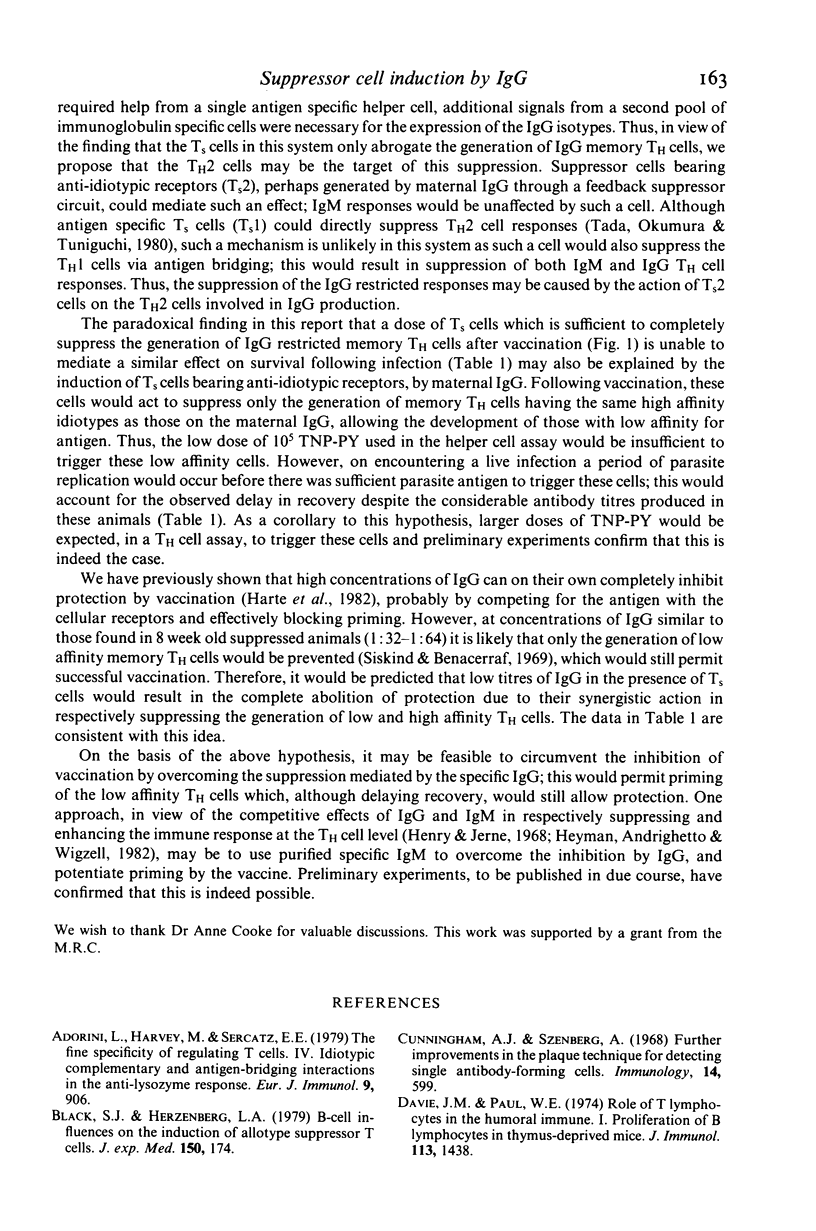Abstract
Female BALB/c mice were vaccinated against blood stage P. yoelii malaria, infected 2 weeks later and after recovery mated to C57B1/6 males. When their offspring were subsequently vaccinated, the effectiveness of vaccination, as assessed by survival after infection, was significantly impaired until 8 weeks of age. Cell and serum transfer experiments indicated that specific maternally derived IgG interferes with protection in two distinct ways: (1) directly by prevention of priming by the vaccine and (2) indirectly by the induction and maintenance of specific suppressor T cells (TS) which act to inhibit the generation of memory T helper cells involved in IgG production, as measured by the response to TNP-P. yoelii. Furthermore, it is shown that the maternal IgG and the TS cells act in synergy to abolish the protective effect of vaccination.
Full text
PDF







Images in this article
Selected References
These references are in PubMed. This may not be the complete list of references from this article.
- Adorini L., Harvey M., Sercarz E. E. The fine specificity of regulatory T cells. IV. Idiotypic complementarity and antigen-bridging interactions in the anti-lysozyme response. Eur J Immunol. 1979 Nov;9(11):906–909. doi: 10.1002/eji.1830091113. [DOI] [PubMed] [Google Scholar]
- Benacerraf B., Germain R. N. A single major pathway of T-lymphocyte interactions in antigen-specific immune suppression. Scand J Immunol. 1981;13(1):1–10. doi: 10.1111/j.1365-3083.1981.tb00104.x. [DOI] [PubMed] [Google Scholar]
- Black S. J., Herzenberg L. A. B-cell influences on the induction of allotype suppressor T cells. J Exp Med. 1979 Jul 1;150(1):174–183. doi: 10.1084/jem.150.1.174. [DOI] [PMC free article] [PubMed] [Google Scholar]
- Cunningham A. J., Szenberg A. Further improvements in the plaque technique for detecting single antibody-forming cells. Immunology. 1968 Apr;14(4):599–600. [PMC free article] [PubMed] [Google Scholar]
- Davie J. M., Paul W. E. Role of T lymphocytes in the humoral immune response. I. Proliferation of B lymphocytes in thymus-deprived mice. J Immunol. 1974 Nov;113(5):1438–1445. [PubMed] [Google Scholar]
- Eichmann K. Idiotype suppression. II. Amplification of a suppressor T cell with anti-idiotypic activity. Eur J Immunol. 1975 Aug;5(8):511–517. doi: 10.1002/eji.1830050802. [DOI] [PubMed] [Google Scholar]
- Harte P. G., De Souza J. B., Playfair J. H. Failure of malaria vaccination in mice born to immune mothers. Clin Exp Immunol. 1982 Sep;49(3):509–516. [PMC free article] [PubMed] [Google Scholar]
- Henry C., Jerne N. K. Competition of 19S and 7S antigen receptors in the regulation of the primary immune response. J Exp Med. 1968 Jul 1;128(1):133–152. doi: 10.1084/jem.128.1.133. [DOI] [PMC free article] [PubMed] [Google Scholar]
- Heyman B., Andrighetto G., Wigzell H. Antigen-dependent IgM-mediated enhancement of the sheep erythrocyte response in mice. Evidence for induction of B cells with specificities other than that of the injected antibodies. J Exp Med. 1982 Apr 1;155(4):994–1009. doi: 10.1084/jem.155.4.994. [DOI] [PMC free article] [PubMed] [Google Scholar]
- Janeway C. A., Jr Cellular cooperation during in vivo anti-hapten antibody responses. I. The effect of cell number on the response. J Immunol. 1975 Apr;114(4):1394–1401. [PubMed] [Google Scholar]
- Lewis G. K., Goodman J. W. Purification of functional, determinant-specific, idiotype-bearing murine T cells. J Exp Med. 1978 Oct 1;148(4):915–924. doi: 10.1084/jem.148.4.915. [DOI] [PMC free article] [PubMed] [Google Scholar]
- Mitchison N. A. The carrier effect in the secondary response to hapten-protein conjugates. V. Use of antilymphocyte serum to deplete animals of helper cells. Eur J Immunol. 1971 Apr;1(2):68–75. doi: 10.1002/eji.1830010204. [DOI] [PubMed] [Google Scholar]
- Owen F. L., Ju S. T., Nisonoff A. Binding to idiotypic determinants of large proportions of thymus-derived lymphocytes in idiotypically suppressed mice. Proc Natl Acad Sci U S A. 1977 May;74(5):2084–2088. doi: 10.1073/pnas.74.5.2084. [DOI] [PMC free article] [PubMed] [Google Scholar]
- Playfair J. H., De Souza J. B., Cottrell B. J. Reactivity and crossreactivity of mouse helper T cells to malaria parasites. Immunology. 1977 May;32(5):681–687. [PMC free article] [PubMed] [Google Scholar]
- Rittenberg M. B., Pratt K. L. Antitrinitrophenyl (TNP) plaque assay. Primary response of Balb/c mice to soluble and particulate immunogen. Proc Soc Exp Biol Med. 1969 Nov;132(2):575–581. doi: 10.3181/00379727-132-34264. [DOI] [PubMed] [Google Scholar]
- Rosenberg Y. J., Asofsky R. T cell regulation of isotype expression. The requirement for a second Ig-specific helper T cell population for the induction of IgG responses. Eur J Immunol. 1981 Sep;11(9):705–710. doi: 10.1002/eji.1830110907. [DOI] [PubMed] [Google Scholar]
- Siskind G. W., Benacerraf B. Cell selection by antigen in the immune response. Adv Immunol. 1969;10:1–50. doi: 10.1016/s0065-2776(08)60414-9. [DOI] [PubMed] [Google Scholar]
- Voller A., O'Neill P. Immunofluorescence method suitable for large-scale application to malaria. Bull World Health Organ. 1971;45(4):524–529. [PMC free article] [PubMed] [Google Scholar]
- Woodland R., Cantor H. Idiotype-specific T helper cells are required to induce idiotype-positive B memory cells to secrete antibody. Eur J Immunol. 1978 Aug;8(8):600–606. doi: 10.1002/eji.1830080812. [DOI] [PubMed] [Google Scholar]



